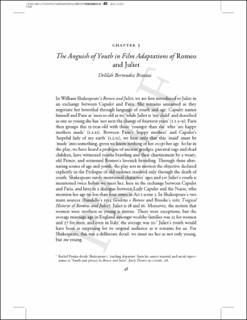| dc.contributor.author | Brataas, Delilah Bermudez | |
| dc.date.accessioned | 2023-11-08T08:26:53Z | |
| dc.date.available | 2023-11-08T08:26:53Z | |
| dc.date.created | 2023-04-25T15:14:05Z | |
| dc.date.issued | 2023 | |
| dc.identifier.isbn | 9781009200905 | |
| dc.identifier.uri | https://hdl.handle.net/11250/3101266 | |
| dc.description.abstract | Of Shakespeare’s plays, none is so commonly adapted and appropriated in forms targeted towards youth audiences as Romeo and Juliet. This chapter considers three film adaptations of Romeo and Juliet through the lens of each film’s engagement with youth, and through their use of setting, props, performance and cinematography to affect, and thereby, emphasize the anguish of (and in) youth. It will be argued that each film’s means of affecting anguish requires a connection to youth as a privileged time of allowable indulgence. Anguish emerges as simultaneously pleasurable in its existential engagement, and painful in its tragic realism, and the effect is a privileging of anguish over the catharsis that conventionally concludes tragedy, leaving anguish and youth sustained indefinitely. | en_US |
| dc.language.iso | eng | en_US |
| dc.publisher | Cambridge University Press | en_US |
| dc.relation.ispartof | Shakespeare on Screen: Romeo and Juliet | |
| dc.title | The Anguish of Youth in Film Adaptations of Romeo and Juliet | en_US |
| dc.title.alternative | The Anguish of Youth in Film Adaptations of Romeo and Juliet | en_US |
| dc.type | Chapter | en_US |
| dc.description.version | acceptedVersion | en_US |
| dc.source.pagenumber | 48-61 | en_US |
| dc.identifier.doi | https://doi.org/10.1017/9781009200905.004 | |
| dc.identifier.cristin | 2143265 | |
| cristin.ispublished | true | |
| cristin.fulltext | postprint | |
| cristin.qualitycode | 2 | |
